Leadership & Management: Health & Social Care Organizational Policy
VerifiedAdded on 2023/06/09
|10
|2436
|500
Report
AI Summary
This report provides an in-depth analysis of leadership and management principles within the health and social care sector. It evaluates the challenges faced by leaders and managers, including rising costs and the increasing use of telehealth, and examines the factors influencing staff performance at Treetops Care Home, such as hectic schedules and non-cooperative patients. The report also identifies key factors contributing to job satisfaction, such as professional opportunities and a positive working environment, and highlights the role of performance management in enhancing patient care and reducing turnover. Furthermore, it explores the development and effectiveness of teams using the Lencioni and Tuckman models, emphasizing the benefits of teamwork in improving patient outcomes and reducing medical errors. The report also outlines the roles, responsibilities, and accountabilities within a health and social care setting, and evaluates the contribution of problem-solving in the development and implementation of organizational policies, concluding that effective leadership and management are crucial for the success of health and social care organizations.

Principles of Leadership
and Management
and Management
Paraphrase This Document
Need a fresh take? Get an instant paraphrase of this document with our AI Paraphraser
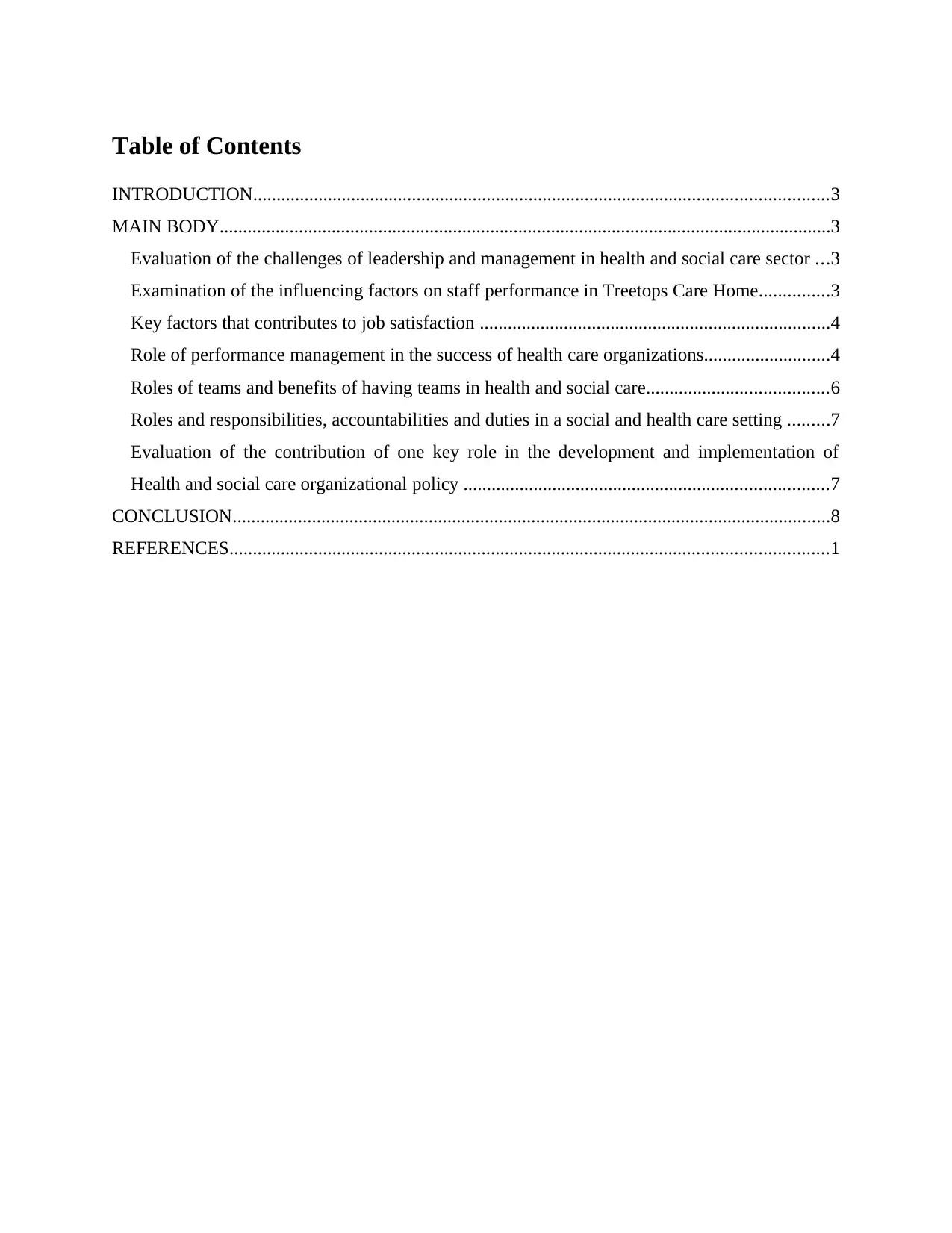
Table of Contents
INTRODUCTION...........................................................................................................................3
MAIN BODY...................................................................................................................................3
Evaluation of the challenges of leadership and management in health and social care sector ...3
Examination of the influencing factors on staff performance in Treetops Care Home...............3
Key factors that contributes to job satisfaction ...........................................................................4
Role of performance management in the success of health care organizations...........................4
Roles of teams and benefits of having teams in health and social care.......................................6
Roles and responsibilities, accountabilities and duties in a social and health care setting .........7
Evaluation of the contribution of one key role in the development and implementation of
Health and social care organizational policy ..............................................................................7
CONCLUSION................................................................................................................................8
REFERENCES................................................................................................................................1
INTRODUCTION...........................................................................................................................3
MAIN BODY...................................................................................................................................3
Evaluation of the challenges of leadership and management in health and social care sector ...3
Examination of the influencing factors on staff performance in Treetops Care Home...............3
Key factors that contributes to job satisfaction ...........................................................................4
Role of performance management in the success of health care organizations...........................4
Roles of teams and benefits of having teams in health and social care.......................................6
Roles and responsibilities, accountabilities and duties in a social and health care setting .........7
Evaluation of the contribution of one key role in the development and implementation of
Health and social care organizational policy ..............................................................................7
CONCLUSION................................................................................................................................8
REFERENCES................................................................................................................................1
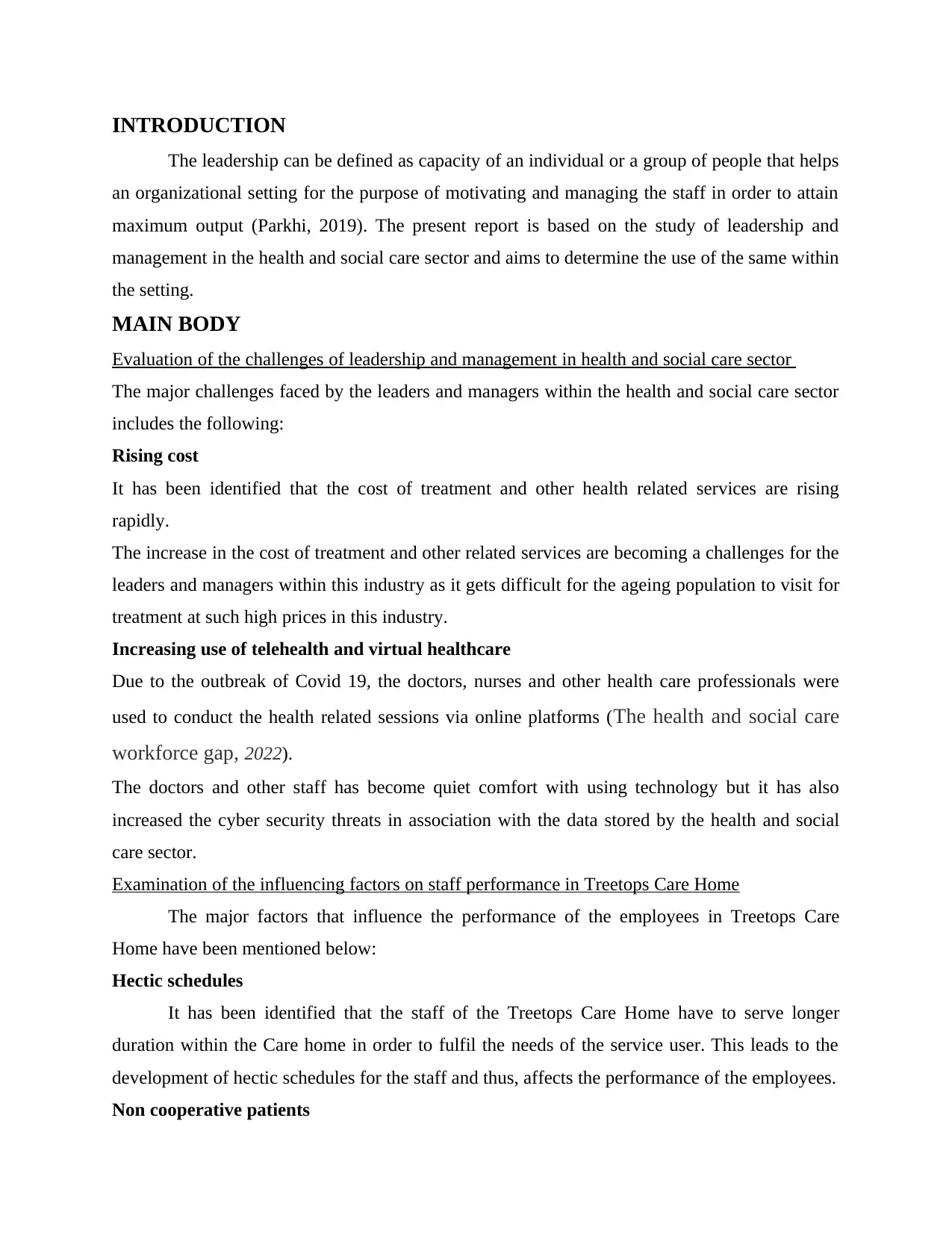
INTRODUCTION
The leadership can be defined as capacity of an individual or a group of people that helps
an organizational setting for the purpose of motivating and managing the staff in order to attain
maximum output (Parkhi, 2019). The present report is based on the study of leadership and
management in the health and social care sector and aims to determine the use of the same within
the setting.
MAIN BODY
Evaluation of the challenges of leadership and management in health and social care sector
The major challenges faced by the leaders and managers within the health and social care sector
includes the following:
Rising cost
It has been identified that the cost of treatment and other health related services are rising
rapidly.
The increase in the cost of treatment and other related services are becoming a challenges for the
leaders and managers within this industry as it gets difficult for the ageing population to visit for
treatment at such high prices in this industry.
Increasing use of telehealth and virtual healthcare
Due to the outbreak of Covid 19, the doctors, nurses and other health care professionals were
used to conduct the health related sessions via online platforms (The health and social care
workforce gap, 2022).
The doctors and other staff has become quiet comfort with using technology but it has also
increased the cyber security threats in association with the data stored by the health and social
care sector.
Examination of the influencing factors on staff performance in Treetops Care Home
The major factors that influence the performance of the employees in Treetops Care
Home have been mentioned below:
Hectic schedules
It has been identified that the staff of the Treetops Care Home have to serve longer
duration within the Care home in order to fulfil the needs of the service user. This leads to the
development of hectic schedules for the staff and thus, affects the performance of the employees.
Non cooperative patients
The leadership can be defined as capacity of an individual or a group of people that helps
an organizational setting for the purpose of motivating and managing the staff in order to attain
maximum output (Parkhi, 2019). The present report is based on the study of leadership and
management in the health and social care sector and aims to determine the use of the same within
the setting.
MAIN BODY
Evaluation of the challenges of leadership and management in health and social care sector
The major challenges faced by the leaders and managers within the health and social care sector
includes the following:
Rising cost
It has been identified that the cost of treatment and other health related services are rising
rapidly.
The increase in the cost of treatment and other related services are becoming a challenges for the
leaders and managers within this industry as it gets difficult for the ageing population to visit for
treatment at such high prices in this industry.
Increasing use of telehealth and virtual healthcare
Due to the outbreak of Covid 19, the doctors, nurses and other health care professionals were
used to conduct the health related sessions via online platforms (The health and social care
workforce gap, 2022).
The doctors and other staff has become quiet comfort with using technology but it has also
increased the cyber security threats in association with the data stored by the health and social
care sector.
Examination of the influencing factors on staff performance in Treetops Care Home
The major factors that influence the performance of the employees in Treetops Care
Home have been mentioned below:
Hectic schedules
It has been identified that the staff of the Treetops Care Home have to serve longer
duration within the Care home in order to fulfil the needs of the service user. This leads to the
development of hectic schedules for the staff and thus, affects the performance of the employees.
Non cooperative patients
⊘ This is a preview!⊘
Do you want full access?
Subscribe today to unlock all pages.

Trusted by 1+ million students worldwide
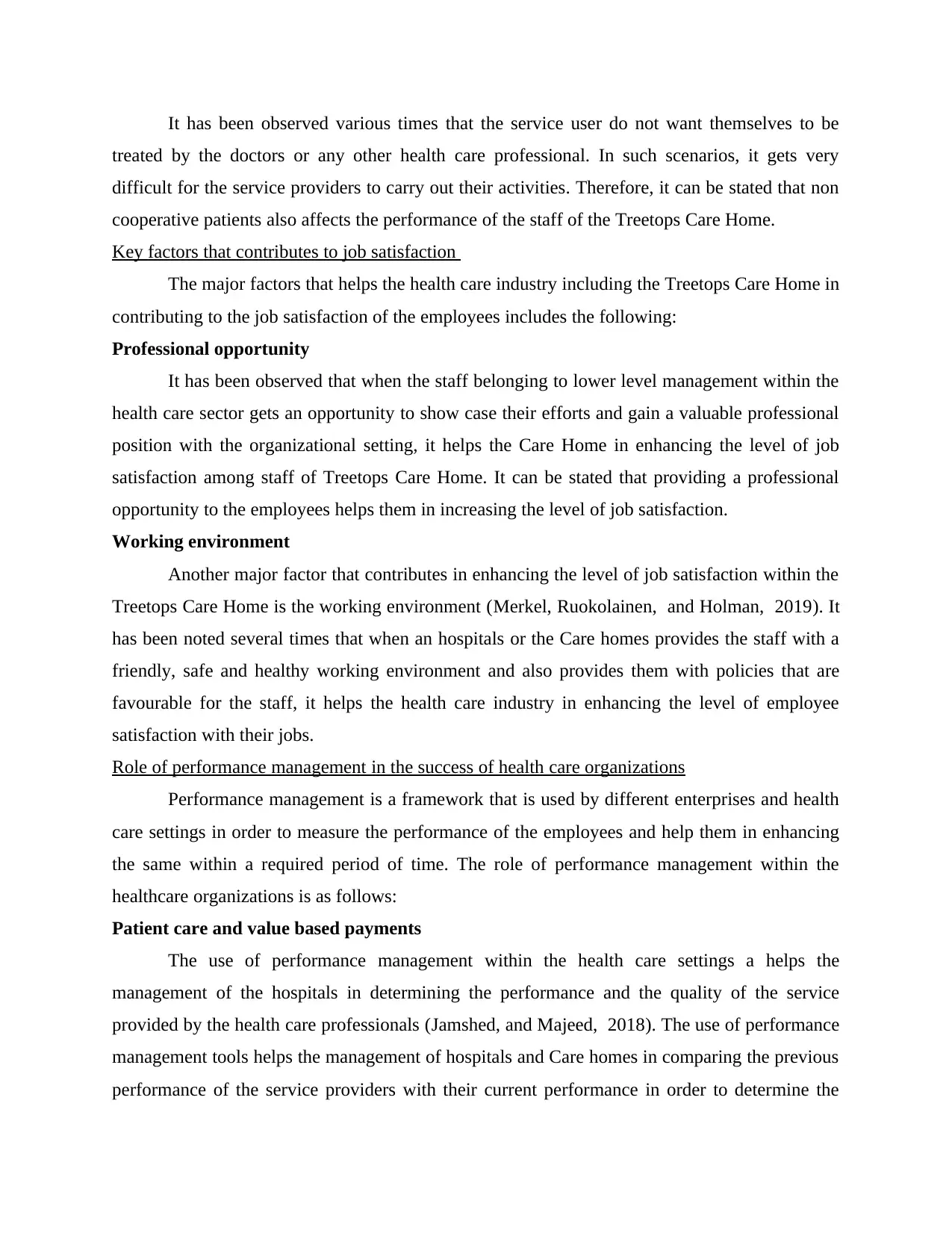
It has been observed various times that the service user do not want themselves to be
treated by the doctors or any other health care professional. In such scenarios, it gets very
difficult for the service providers to carry out their activities. Therefore, it can be stated that non
cooperative patients also affects the performance of the staff of the Treetops Care Home.
Key factors that contributes to job satisfaction
The major factors that helps the health care industry including the Treetops Care Home in
contributing to the job satisfaction of the employees includes the following:
Professional opportunity
It has been observed that when the staff belonging to lower level management within the
health care sector gets an opportunity to show case their efforts and gain a valuable professional
position with the organizational setting, it helps the Care Home in enhancing the level of job
satisfaction among staff of Treetops Care Home. It can be stated that providing a professional
opportunity to the employees helps them in increasing the level of job satisfaction.
Working environment
Another major factor that contributes in enhancing the level of job satisfaction within the
Treetops Care Home is the working environment (Merkel, Ruokolainen, and Holman, 2019). It
has been noted several times that when an hospitals or the Care homes provides the staff with a
friendly, safe and healthy working environment and also provides them with policies that are
favourable for the staff, it helps the health care industry in enhancing the level of employee
satisfaction with their jobs.
Role of performance management in the success of health care organizations
Performance management is a framework that is used by different enterprises and health
care settings in order to measure the performance of the employees and help them in enhancing
the same within a required period of time. The role of performance management within the
healthcare organizations is as follows:
Patient care and value based payments
The use of performance management within the health care settings a helps the
management of the hospitals in determining the performance and the quality of the service
provided by the health care professionals (Jamshed, and Majeed, 2018). The use of performance
management tools helps the management of hospitals and Care homes in comparing the previous
performance of the service providers with their current performance in order to determine the
treated by the doctors or any other health care professional. In such scenarios, it gets very
difficult for the service providers to carry out their activities. Therefore, it can be stated that non
cooperative patients also affects the performance of the staff of the Treetops Care Home.
Key factors that contributes to job satisfaction
The major factors that helps the health care industry including the Treetops Care Home in
contributing to the job satisfaction of the employees includes the following:
Professional opportunity
It has been observed that when the staff belonging to lower level management within the
health care sector gets an opportunity to show case their efforts and gain a valuable professional
position with the organizational setting, it helps the Care Home in enhancing the level of job
satisfaction among staff of Treetops Care Home. It can be stated that providing a professional
opportunity to the employees helps them in increasing the level of job satisfaction.
Working environment
Another major factor that contributes in enhancing the level of job satisfaction within the
Treetops Care Home is the working environment (Merkel, Ruokolainen, and Holman, 2019). It
has been noted several times that when an hospitals or the Care homes provides the staff with a
friendly, safe and healthy working environment and also provides them with policies that are
favourable for the staff, it helps the health care industry in enhancing the level of employee
satisfaction with their jobs.
Role of performance management in the success of health care organizations
Performance management is a framework that is used by different enterprises and health
care settings in order to measure the performance of the employees and help them in enhancing
the same within a required period of time. The role of performance management within the
healthcare organizations is as follows:
Patient care and value based payments
The use of performance management within the health care settings a helps the
management of the hospitals in determining the performance and the quality of the service
provided by the health care professionals (Jamshed, and Majeed, 2018). The use of performance
management tools helps the management of hospitals and Care homes in comparing the previous
performance of the service providers with their current performance in order to determine the
Paraphrase This Document
Need a fresh take? Get an instant paraphrase of this document with our AI Paraphraser
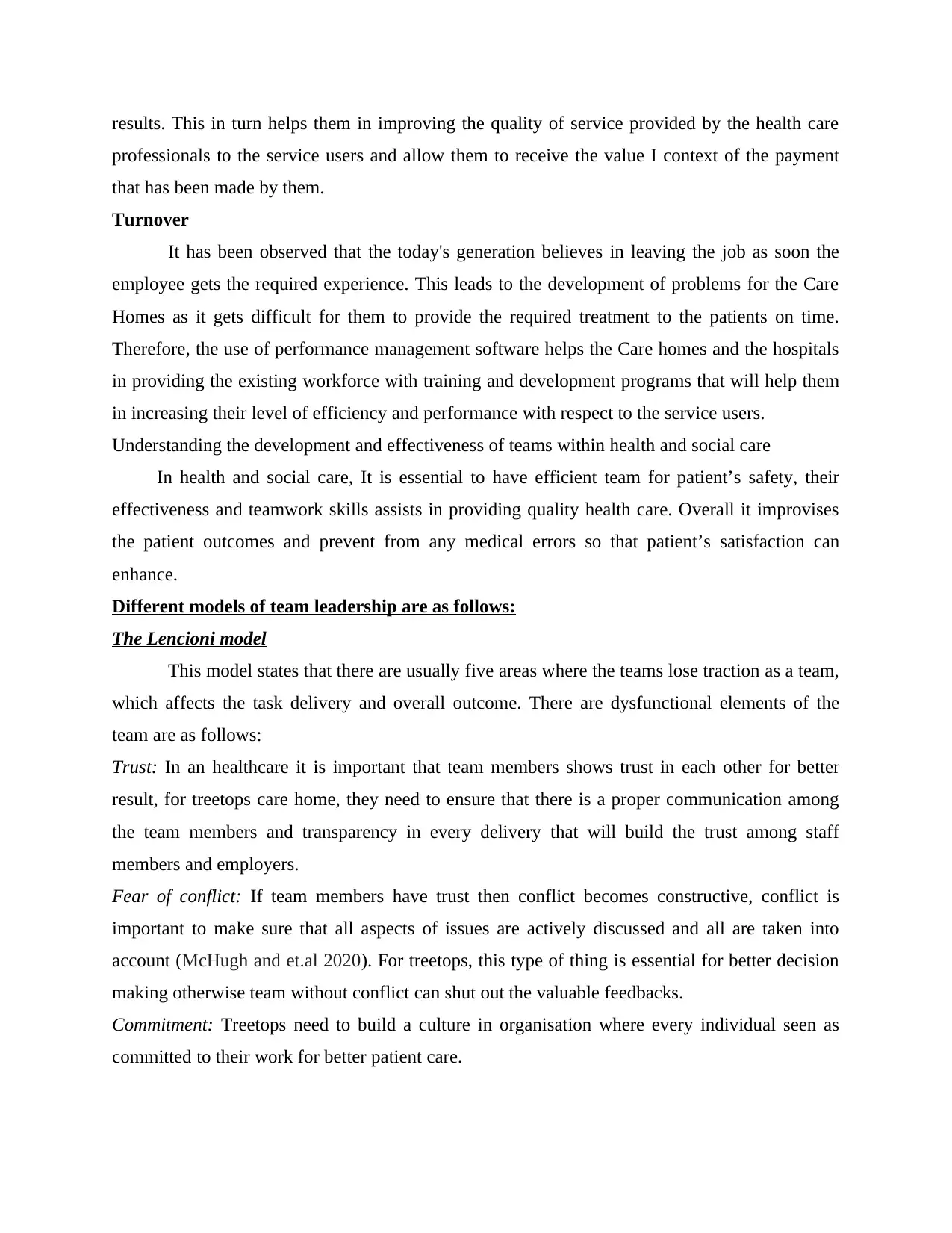
results. This in turn helps them in improving the quality of service provided by the health care
professionals to the service users and allow them to receive the value I context of the payment
that has been made by them.
Turnover
It has been observed that the today's generation believes in leaving the job as soon the
employee gets the required experience. This leads to the development of problems for the Care
Homes as it gets difficult for them to provide the required treatment to the patients on time.
Therefore, the use of performance management software helps the Care homes and the hospitals
in providing the existing workforce with training and development programs that will help them
in increasing their level of efficiency and performance with respect to the service users.
Understanding the development and effectiveness of teams within health and social care
In health and social care, It is essential to have efficient team for patient’s safety, their
effectiveness and teamwork skills assists in providing quality health care. Overall it improvises
the patient outcomes and prevent from any medical errors so that patient’s satisfaction can
enhance.
Different models of team leadership are as follows:
The Lencioni model
This model states that there are usually five areas where the teams lose traction as a team,
which affects the task delivery and overall outcome. There are dysfunctional elements of the
team are as follows:
Trust: In an healthcare it is important that team members shows trust in each other for better
result, for treetops care home, they need to ensure that there is a proper communication among
the team members and transparency in every delivery that will build the trust among staff
members and employers.
Fear of conflict: If team members have trust then conflict becomes constructive, conflict is
important to make sure that all aspects of issues are actively discussed and all are taken into
account (McHugh and et.al 2020). For treetops, this type of thing is essential for better decision
making otherwise team without conflict can shut out the valuable feedbacks.
Commitment: Treetops need to build a culture in organisation where every individual seen as
committed to their work for better patient care.
professionals to the service users and allow them to receive the value I context of the payment
that has been made by them.
Turnover
It has been observed that the today's generation believes in leaving the job as soon the
employee gets the required experience. This leads to the development of problems for the Care
Homes as it gets difficult for them to provide the required treatment to the patients on time.
Therefore, the use of performance management software helps the Care homes and the hospitals
in providing the existing workforce with training and development programs that will help them
in increasing their level of efficiency and performance with respect to the service users.
Understanding the development and effectiveness of teams within health and social care
In health and social care, It is essential to have efficient team for patient’s safety, their
effectiveness and teamwork skills assists in providing quality health care. Overall it improvises
the patient outcomes and prevent from any medical errors so that patient’s satisfaction can
enhance.
Different models of team leadership are as follows:
The Lencioni model
This model states that there are usually five areas where the teams lose traction as a team,
which affects the task delivery and overall outcome. There are dysfunctional elements of the
team are as follows:
Trust: In an healthcare it is important that team members shows trust in each other for better
result, for treetops care home, they need to ensure that there is a proper communication among
the team members and transparency in every delivery that will build the trust among staff
members and employers.
Fear of conflict: If team members have trust then conflict becomes constructive, conflict is
important to make sure that all aspects of issues are actively discussed and all are taken into
account (McHugh and et.al 2020). For treetops, this type of thing is essential for better decision
making otherwise team without conflict can shut out the valuable feedbacks.
Commitment: Treetops need to build a culture in organisation where every individual seen as
committed to their work for better patient care.
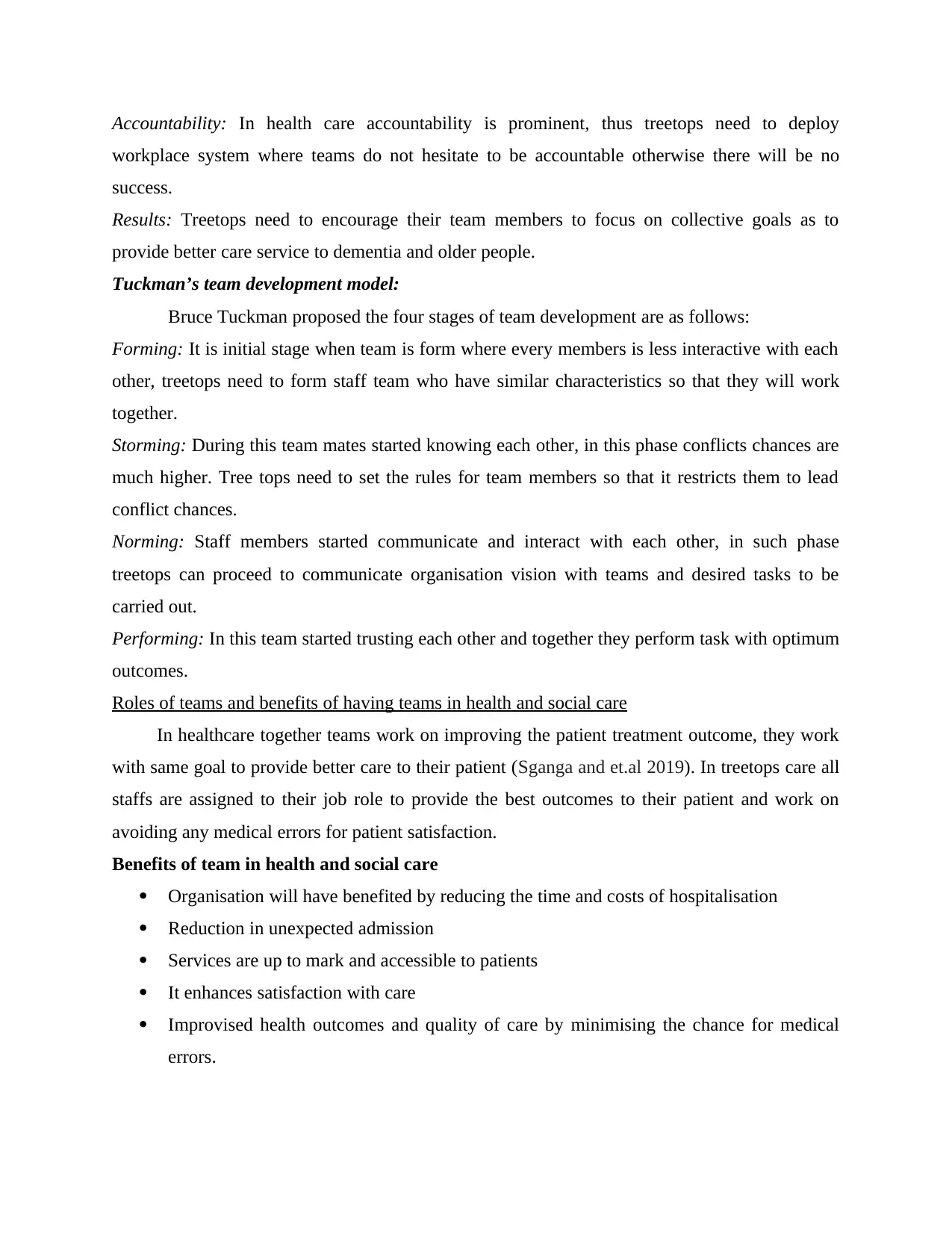
Accountability: In health care accountability is prominent, thus treetops need to deploy
workplace system where teams do not hesitate to be accountable otherwise there will be no
success.
Results: Treetops need to encourage their team members to focus on collective goals as to
provide better care service to dementia and older people.
Tuckman’s team development model:
Bruce Tuckman proposed the four stages of team development are as follows:
Forming: It is initial stage when team is form where every members is less interactive with each
other, treetops need to form staff team who have similar characteristics so that they will work
together.
Storming: During this team mates started knowing each other, in this phase conflicts chances are
much higher. Tree tops need to set the rules for team members so that it restricts them to lead
conflict chances.
Norming: Staff members started communicate and interact with each other, in such phase
treetops can proceed to communicate organisation vision with teams and desired tasks to be
carried out.
Performing: In this team started trusting each other and together they perform task with optimum
outcomes.
Roles of teams and benefits of having teams in health and social care
In healthcare together teams work on improving the patient treatment outcome, they work
with same goal to provide better care to their patient (Sganga and et.al 2019). In treetops care all
staffs are assigned to their job role to provide the best outcomes to their patient and work on
avoiding any medical errors for patient satisfaction.
Benefits of team in health and social care
Organisation will have benefited by reducing the time and costs of hospitalisation
Reduction in unexpected admission
Services are up to mark and accessible to patients
It enhances satisfaction with care
Improvised health outcomes and quality of care by minimising the chance for medical
errors.
workplace system where teams do not hesitate to be accountable otherwise there will be no
success.
Results: Treetops need to encourage their team members to focus on collective goals as to
provide better care service to dementia and older people.
Tuckman’s team development model:
Bruce Tuckman proposed the four stages of team development are as follows:
Forming: It is initial stage when team is form where every members is less interactive with each
other, treetops need to form staff team who have similar characteristics so that they will work
together.
Storming: During this team mates started knowing each other, in this phase conflicts chances are
much higher. Tree tops need to set the rules for team members so that it restricts them to lead
conflict chances.
Norming: Staff members started communicate and interact with each other, in such phase
treetops can proceed to communicate organisation vision with teams and desired tasks to be
carried out.
Performing: In this team started trusting each other and together they perform task with optimum
outcomes.
Roles of teams and benefits of having teams in health and social care
In healthcare together teams work on improving the patient treatment outcome, they work
with same goal to provide better care to their patient (Sganga and et.al 2019). In treetops care all
staffs are assigned to their job role to provide the best outcomes to their patient and work on
avoiding any medical errors for patient satisfaction.
Benefits of team in health and social care
Organisation will have benefited by reducing the time and costs of hospitalisation
Reduction in unexpected admission
Services are up to mark and accessible to patients
It enhances satisfaction with care
Improvised health outcomes and quality of care by minimising the chance for medical
errors.
⊘ This is a preview!⊘
Do you want full access?
Subscribe today to unlock all pages.

Trusted by 1+ million students worldwide
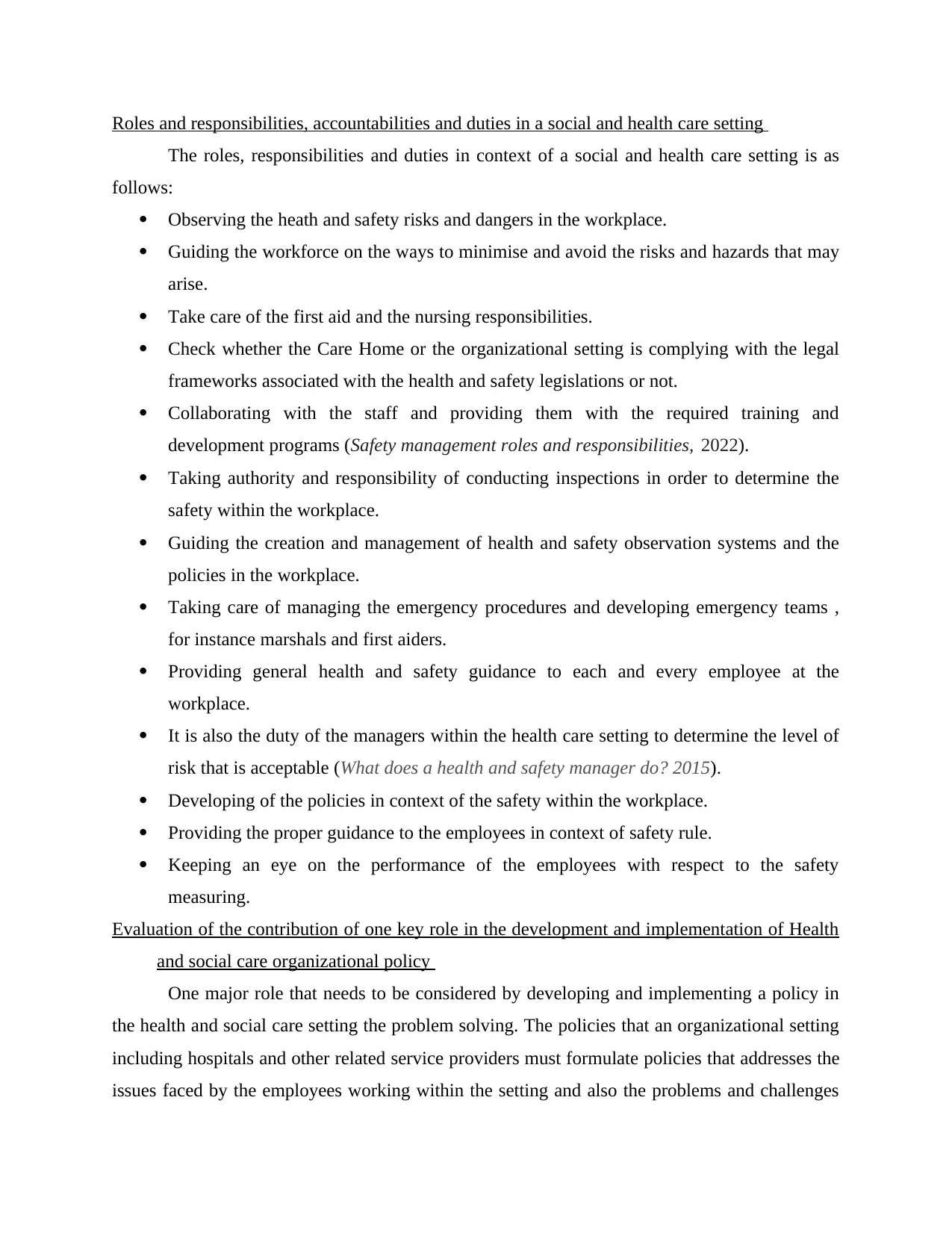
Roles and responsibilities, accountabilities and duties in a social and health care setting
The roles, responsibilities and duties in context of a social and health care setting is as
follows:
Observing the heath and safety risks and dangers in the workplace.
Guiding the workforce on the ways to minimise and avoid the risks and hazards that may
arise.
Take care of the first aid and the nursing responsibilities.
Check whether the Care Home or the organizational setting is complying with the legal
frameworks associated with the health and safety legislations or not.
Collaborating with the staff and providing them with the required training and
development programs (Safety management roles and responsibilities, 2022).
Taking authority and responsibility of conducting inspections in order to determine the
safety within the workplace.
Guiding the creation and management of health and safety observation systems and the
policies in the workplace.
Taking care of managing the emergency procedures and developing emergency teams ,
for instance marshals and first aiders.
Providing general health and safety guidance to each and every employee at the
workplace.
It is also the duty of the managers within the health care setting to determine the level of
risk that is acceptable (What does a health and safety manager do? 2015).
Developing of the policies in context of the safety within the workplace.
Providing the proper guidance to the employees in context of safety rule.
Keeping an eye on the performance of the employees with respect to the safety
measuring.
Evaluation of the contribution of one key role in the development and implementation of Health
and social care organizational policy
One major role that needs to be considered by developing and implementing a policy in
the health and social care setting the problem solving. The policies that an organizational setting
including hospitals and other related service providers must formulate policies that addresses the
issues faced by the employees working within the setting and also the problems and challenges
The roles, responsibilities and duties in context of a social and health care setting is as
follows:
Observing the heath and safety risks and dangers in the workplace.
Guiding the workforce on the ways to minimise and avoid the risks and hazards that may
arise.
Take care of the first aid and the nursing responsibilities.
Check whether the Care Home or the organizational setting is complying with the legal
frameworks associated with the health and safety legislations or not.
Collaborating with the staff and providing them with the required training and
development programs (Safety management roles and responsibilities, 2022).
Taking authority and responsibility of conducting inspections in order to determine the
safety within the workplace.
Guiding the creation and management of health and safety observation systems and the
policies in the workplace.
Taking care of managing the emergency procedures and developing emergency teams ,
for instance marshals and first aiders.
Providing general health and safety guidance to each and every employee at the
workplace.
It is also the duty of the managers within the health care setting to determine the level of
risk that is acceptable (What does a health and safety manager do? 2015).
Developing of the policies in context of the safety within the workplace.
Providing the proper guidance to the employees in context of safety rule.
Keeping an eye on the performance of the employees with respect to the safety
measuring.
Evaluation of the contribution of one key role in the development and implementation of Health
and social care organizational policy
One major role that needs to be considered by developing and implementing a policy in
the health and social care setting the problem solving. The policies that an organizational setting
including hospitals and other related service providers must formulate policies that addresses the
issues faced by the employees working within the setting and also the problems and challenges
Paraphrase This Document
Need a fresh take? Get an instant paraphrase of this document with our AI Paraphraser
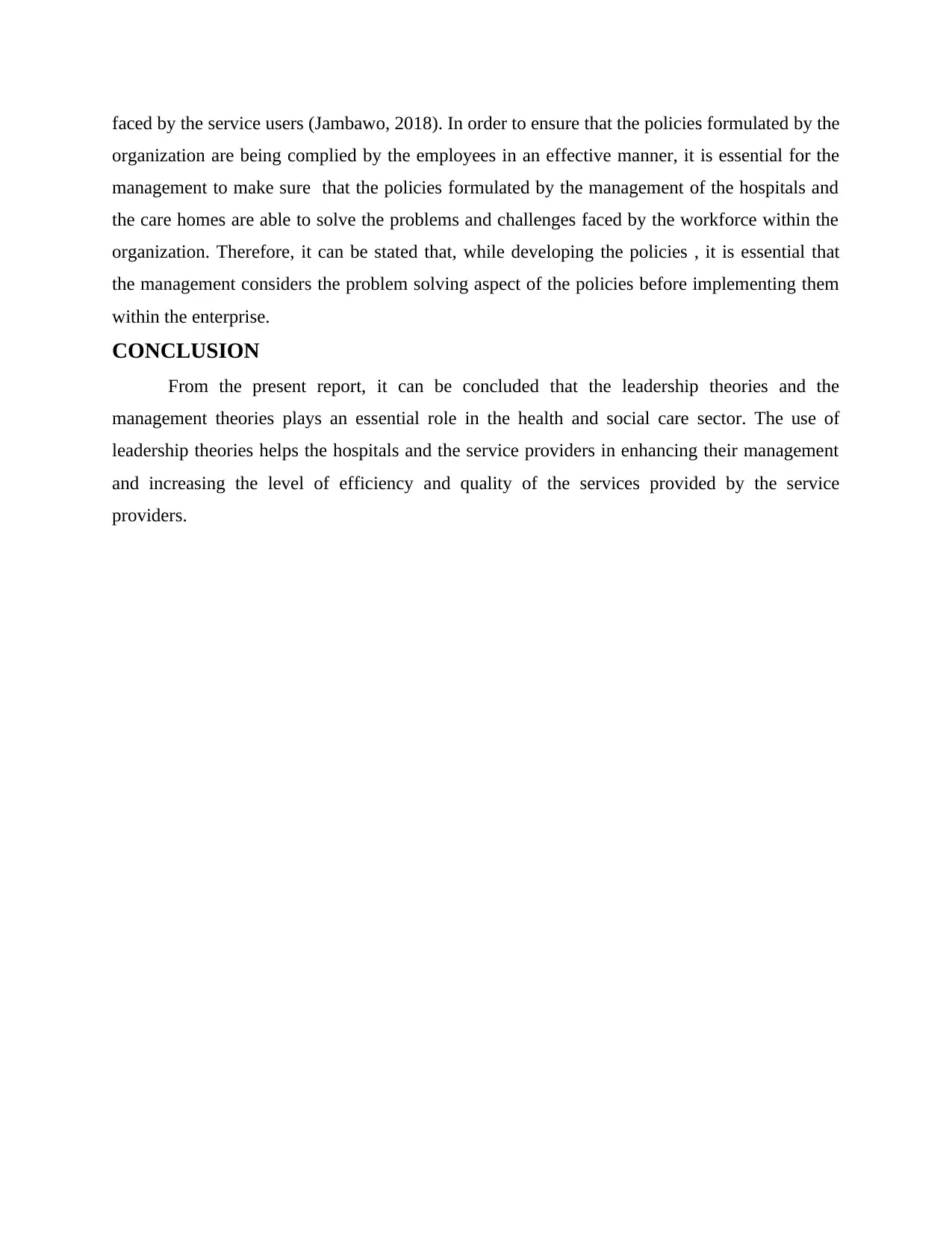
faced by the service users (Jambawo, 2018). In order to ensure that the policies formulated by the
organization are being complied by the employees in an effective manner, it is essential for the
management to make sure that the policies formulated by the management of the hospitals and
the care homes are able to solve the problems and challenges faced by the workforce within the
organization. Therefore, it can be stated that, while developing the policies , it is essential that
the management considers the problem solving aspect of the policies before implementing them
within the enterprise.
CONCLUSION
From the present report, it can be concluded that the leadership theories and the
management theories plays an essential role in the health and social care sector. The use of
leadership theories helps the hospitals and the service providers in enhancing their management
and increasing the level of efficiency and quality of the services provided by the service
providers.
organization are being complied by the employees in an effective manner, it is essential for the
management to make sure that the policies formulated by the management of the hospitals and
the care homes are able to solve the problems and challenges faced by the workforce within the
organization. Therefore, it can be stated that, while developing the policies , it is essential that
the management considers the problem solving aspect of the policies before implementing them
within the enterprise.
CONCLUSION
From the present report, it can be concluded that the leadership theories and the
management theories plays an essential role in the health and social care sector. The use of
leadership theories helps the hospitals and the service providers in enhancing their management
and increasing the level of efficiency and quality of the services provided by the service
providers.
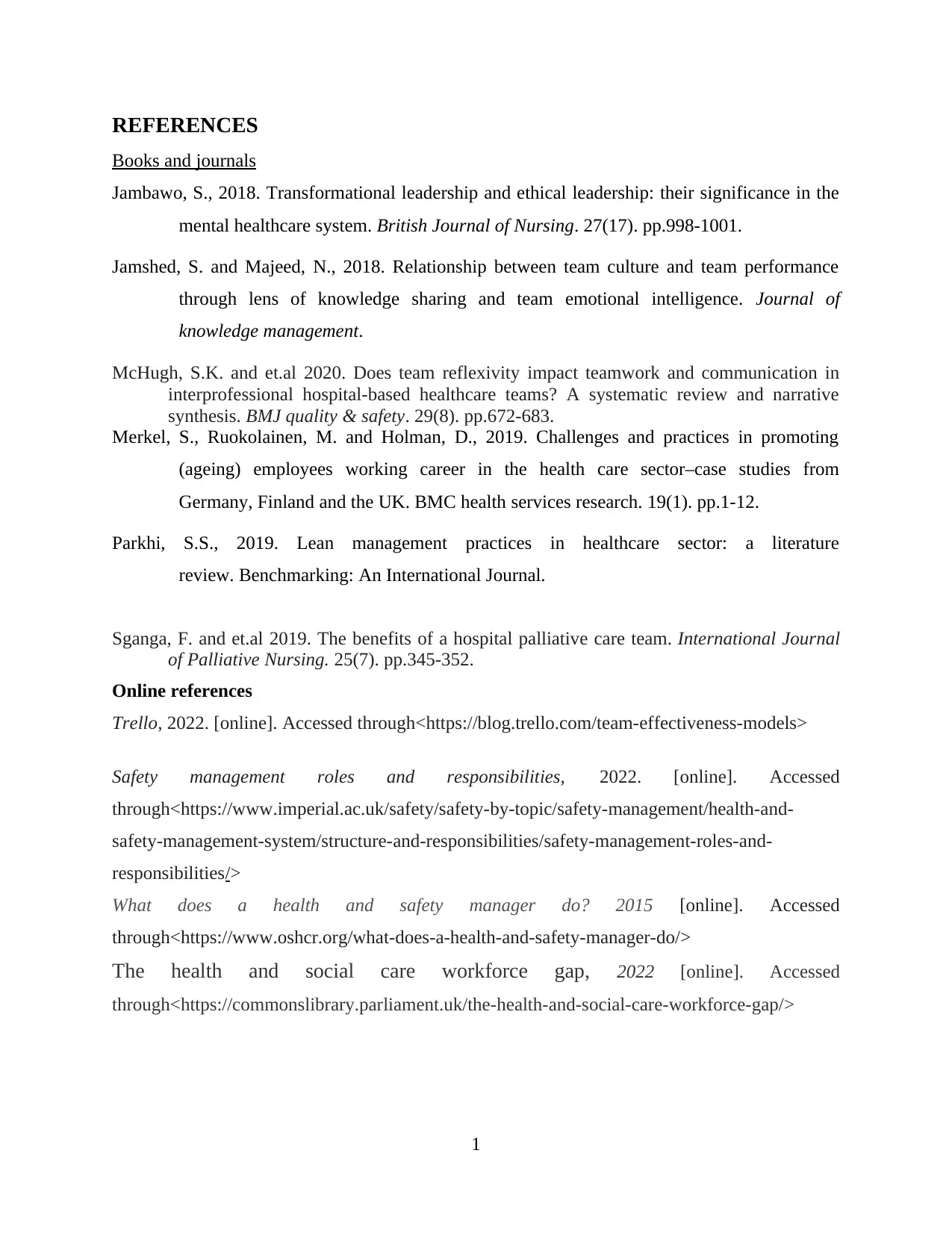
REFERENCES
Books and journals
Jambawo, S., 2018. Transformational leadership and ethical leadership: their significance in the
mental healthcare system. British Journal of Nursing. 27(17). pp.998-1001.
Jamshed, S. and Majeed, N., 2018. Relationship between team culture and team performance
through lens of knowledge sharing and team emotional intelligence. Journal of
knowledge management.
McHugh, S.K. and et.al 2020. Does team reflexivity impact teamwork and communication in
interprofessional hospital-based healthcare teams? A systematic review and narrative
synthesis. BMJ quality & safety. 29(8). pp.672-683.
Merkel, S., Ruokolainen, M. and Holman, D., 2019. Challenges and practices in promoting
(ageing) employees working career in the health care sector–case studies from
Germany, Finland and the UK. BMC health services research. 19(1). pp.1-12.
Parkhi, S.S., 2019. Lean management practices in healthcare sector: a literature
review. Benchmarking: An International Journal.
Sganga, F. and et.al 2019. The benefits of a hospital palliative care team. International Journal
of Palliative Nursing. 25(7). pp.345-352.
Online references
Trello, 2022. [online]. Accessed through<https://blog.trello.com/team-effectiveness-models>
Safety management roles and responsibilities, 2022. [online]. Accessed
through<https://www.imperial.ac.uk/safety/safety-by-topic/safety-management/health-and-
safety-management-system/structure-and-responsibilities/safety-management-roles-and-
responsibilities/>
What does a health and safety manager do? 2015 [online]. Accessed
through<https://www.oshcr.org/what-does-a-health-and-safety-manager-do/>
The health and social care workforce gap, 2022 [online]. Accessed
through<https://commonslibrary.parliament.uk/the-health-and-social-care-workforce-gap/>
1
Books and journals
Jambawo, S., 2018. Transformational leadership and ethical leadership: their significance in the
mental healthcare system. British Journal of Nursing. 27(17). pp.998-1001.
Jamshed, S. and Majeed, N., 2018. Relationship between team culture and team performance
through lens of knowledge sharing and team emotional intelligence. Journal of
knowledge management.
McHugh, S.K. and et.al 2020. Does team reflexivity impact teamwork and communication in
interprofessional hospital-based healthcare teams? A systematic review and narrative
synthesis. BMJ quality & safety. 29(8). pp.672-683.
Merkel, S., Ruokolainen, M. and Holman, D., 2019. Challenges and practices in promoting
(ageing) employees working career in the health care sector–case studies from
Germany, Finland and the UK. BMC health services research. 19(1). pp.1-12.
Parkhi, S.S., 2019. Lean management practices in healthcare sector: a literature
review. Benchmarking: An International Journal.
Sganga, F. and et.al 2019. The benefits of a hospital palliative care team. International Journal
of Palliative Nursing. 25(7). pp.345-352.
Online references
Trello, 2022. [online]. Accessed through<https://blog.trello.com/team-effectiveness-models>
Safety management roles and responsibilities, 2022. [online]. Accessed
through<https://www.imperial.ac.uk/safety/safety-by-topic/safety-management/health-and-
safety-management-system/structure-and-responsibilities/safety-management-roles-and-
responsibilities/>
What does a health and safety manager do? 2015 [online]. Accessed
through<https://www.oshcr.org/what-does-a-health-and-safety-manager-do/>
The health and social care workforce gap, 2022 [online]. Accessed
through<https://commonslibrary.parliament.uk/the-health-and-social-care-workforce-gap/>
1
⊘ This is a preview!⊘
Do you want full access?
Subscribe today to unlock all pages.

Trusted by 1+ million students worldwide

2
1 out of 10
Related Documents
Your All-in-One AI-Powered Toolkit for Academic Success.
+13062052269
info@desklib.com
Available 24*7 on WhatsApp / Email
![[object Object]](/_next/static/media/star-bottom.7253800d.svg)
Unlock your academic potential
Copyright © 2020–2025 A2Z Services. All Rights Reserved. Developed and managed by ZUCOL.


